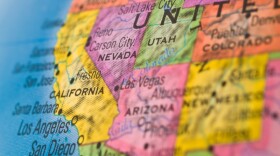There's a big race right now to become the 51st state.
Forget traditional contenders like Puerto Rico. In several existing states, residents of less populous areas are hoping to create new states of their own.
Citizens in 11 mostly northeastern Colorado counties are among them. They'll vote on Nov. 5 whether to break off and form their own state. Many are unhappy about liberal state legislation they believe reflects the values of the Denver-Boulder corridor, but not their part of the world.
"We're rarely listened to when it comes to legislation," says Butch White, the mayor of Ault. "I'm sure the vote will pass in Weld County quite easily."
The Colorado counties aren't alone. There's been occasional talk of secession at various times in recent decades, but now the idea is showing signs of taking root across the map.
There is talk about and sometimes movement toward secession in several states. These are locally motivated startups, but they share some themes in common.
People in mostly conservative areas feel isolated living in states controlled by Democrats. Rural residents, in particular, believe their values are given no respect in capitols now completely dominated by urban and suburban interests.
Secession may be part of the same impulse that leads states to sue or otherwise try to block or nullify federal laws they don't like. People are losing respect for institutions that don't reflect their preferences and would prefer, to the extent possible, to extricate themselves from them.
"What we would like to do is gain representation for the northern people of the state," says Mark Baird, spokesman for a committee seeking to split off part of California. "The only way to do that is to have our own state."
Can't Get No Satisfaction
Among those yearning to break free from their states are people living in largely red counties in blue states who are displeased by new laws addressing such matters as gun control, environmental protection and gun control.
"You have issues that go way beyond gun rights," says Anthony Navarro, owner of Colorado Shooting Sports, a gun shop in Greeley. "You have people in Boulder and Denver who have and are dictating to the rest of the state."
There are some Democrats who have launched trial balloons about splitting off parts of Florida and Arizona, but those ideas haven't caught on.
Secession-minded residents in rural areas complain their voices aren't being heard in distant capitals. Some would like to create new governments from scratch rather than staying forever trapped within a larger state that doesn't reflect their preferences.
"There's no one solution that's going to be perfect, but the fact is we can minimize differences and allow people more choice about how they're governed," says Scott Strzelczyk, head of an initiative seeking to create a new state in western Maryland.
"It's like the Baskin-Robbins of states," he says. "You can actually live in a political society that governs the way you want to be governed. The more choice the better."
Rural Decline
Figures released this summer by the Census Bureau that the country's rural population, for the first time, is in decline. Rural areas now account for about 15 percent of the nation's population.
Even in farm states, rural areas within state legislatures in the last round of redistricting, exacerbating a long-standing trend.
"Greater Los Angeles has something like 34 representatives" in the California Assembly, says Baird, the spokesman for the Jefferson Declaration Committee. "The northern third of California has three."
A similar sense of frustration led to last year on the Upper Peninsula of Michigan, although it appears that effort is gaining no traction.
"We have one-third of the land mass and 3 percent of the population, so it's easy to feel neglected," says Steve Pence, a county commissioner in Marquette, Mich. "It's grounded in the legitimate feeling that if you're marginalized by geography, it's easy to feel neglected by the central government."
Odds Are Against
People in Northern California and southern Oregon have been talking about creating a state of Jefferson for a long time. They went so far as to in 1941 — three days before Pearl Harbor, which brought that particular effort to an end.
In 1965, the state Senate voted to divide the state. That didn't happen, though.
So far, only two counties have approved the latest calls to create a new state, although as many as a dozen more may soon join in.
But no state has been calved from within the borders of an existing state since West Virginia split off from Virginia in 1863.
Secession simply isn't going to happen, says Daniel Farber, a law professor at the University of California, Berkeley, who has the issue. Creation of a new state would require the blessing of the state being spurned, as well as congressional approval.
It's a Catch-22: People who want to secede because they lost influence don't have the influence to make it happen.
"You'd have to persuade the U.S. Senate to add two more senators, but why would they do that, since that would dilute their own state's influence and might well add votes to the opposing party?" Farber says.
The legal and institutional hurdles are high enough that no existing state is likely to be broken up in our lifetimes. But the urge is clearly there.
In this polarized era, lots of states that don't like the direction the federal government is taking have challenged numerous laws in court.
Is it any surprise that people within states show similar dissatisfaction?
"The politics of states have become increasingly polarized," says Tim Conlan, a public policy professor at George Mason University. "Talk of secession from Colorado or Maryland, that's partly related to the same thing. The same demographic polarization is going on within many states."
Copyright 2020 NPR. To see more, visit https://www.npr.org. 9(MDAxNDQ2NDAxMDEyNzU2NzM2ODA3ZGI1ZA001))







